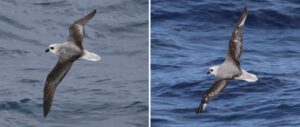 By Peter Ryan, onboard scientist, expert in general ornithology, seabird-fishery interactions, evolutionary ecology, marine debris, solid waste management, biology of oceanic islands.
By Peter Ryan, onboard scientist, expert in general ornithology, seabird-fishery interactions, evolutionary ecology, marine debris, solid waste management, biology of oceanic islands.
Leg 1, Day 26.
Another fairly quiet day on the run northeast towards Hobart; at 10 bird species overall we just managed to beat yesterday’s record low of 9 species, but only thanks to a late appearing Wandering Albatross that briefly circled the ship around 20h15. Today was the day for White-headed Petrels, with flocks of 4-5 together at times. One of the largest Pterodroma petrels, they superficially recall a small juvenile Black-browed Albatross. About half of all the birds seen today were moulting their flight feathers, indicating that they are non-breeding individuals (either immatures, or adults skipping this breeding season). Virtually all prions seen were Fairy Prions, the more slender-billed sibling species to Fulmar Prion. Again, most individuals were in moult, suggesting that these birds also are non-breeders.
| Fairy Prion | 200 | White-headed Petrel | 72 |
| Short-tailed Shearwater | 29 | Mottled Petrel | 4 |
| Grey-headed Albatross | 2 | Antarctic Prion | 2 |
| Southern Rockhopper Penguin | 1 | Diving petrel spp. | 1 |
| Black-bellied Storm Petrel | 1 | Wandering Albatross | + |
Two groups of dolphins were seen. The first, just after lunch, behaved in a subdued manner, surfacing briefly without fuss and remaining in the same spot, unlike the dashing, splashing progress we’ve come to expect from Hourglass Dolphins. Unfortunately their identification was not resolved. The abundance of Bull Kelps increased as we moved into warmer waters north of the Antarctic Polar Front; it is unclear whether the plants seen today originate from Tasmania or Heard/Kerguelen.
